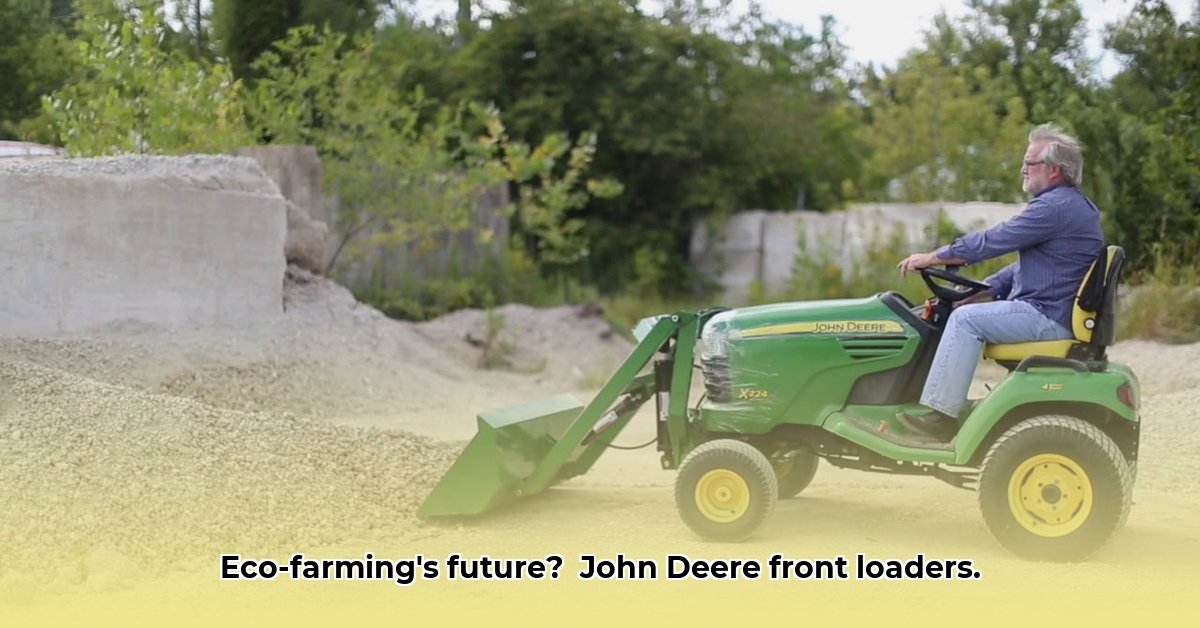
John Deere Garden Tractor Front Loaders: Level Up Your Farm's Efficiency and Eco-Friendliness
Choosing the right front-end loader (FEL) significantly impacts your farm's productivity and environmental footprint. This guide compares John Deere and Little Buck loaders, highlighting their strengths and weaknesses to help you make an informed decision. For more detailed information on John Deere loaders, check out this helpful resource: John Deere Loaders.
John Deere Front Loaders: Smooth Operations and Smart Technology
John Deere garden tractor FELs are renowned for their self-leveling technology. This isn't just a convenience; it's a productivity booster. Effortlessly scoop and move materials, keeping the bucket level regardless of terrain. This translates to less wasted time and effort, directly impacting your bottom line. Models in the 400 and 500 series, for example, boast impressive lifting power, making light work of even the toughest jobs. This increased efficiency means lower fuel consumption and fewer labor hours. But, this advanced technology necessitates a higher initial investment. Proper maintenance is crucial for longevity and minimizing potential mechanical issues. Regular servicing, including lubrication and component inspections, is key to maximizing the return on your investment.
Little Buck Loader: The Budget-Friendly Workhorse
For smaller operations or tighter budgets, the Little Buck Loader offers a cost-effective alternative. Its adaptability shines through its compatibility with a wide range of attachments, such as forks, buckets, and blades, increasing versatility. This adaptability minimizes the need for purchasing multiple pieces of equipment, contributing to both cost savings and a smaller environmental footprint. However, compatibility with your specific tractor model is crucial. Thorough research is essential to prevent compatibility issues. While lacking the self-leveling technology of John Deere, its lower upfront cost makes it an attractive option for smaller farms prioritizing affordability.
Deere vs. Little Buck: A Head-to-Head Comparison
This table summarizes the key differences, informing your decision on which loader best suits your needs and how to choose the best front-end loader for sustainable farm operations:
| Feature | John Deere Front Loader | Little Buck Loader |
|---|---|---|
| Self-Leveling | Yes | No |
| Lift Capacity | High (varies greatly by model) | Moderate (suitable for smaller tasks) |
| Attachment Variety | Generally limited to Deere-specific options | Wide range, often adaptable to different brands |
| Cost | Higher initial investment | Lower initial investment |
| Maintenance | More complex due to sophisticated technology | Usually simpler and less expensive |
| Sustainability | High efficiency translates to lower fuel consumption | Versatile attachments minimize equipment needs |
Choosing the Right Loader: A Step-by-Step Guide
Selecting the right FEL requires careful consideration. Follow these steps:
- Assess Needs: Define tasks (hay moving, light gardening, etc.) and farm size. This assessment forms the foundation of your decision.
- Budgeting: Establish a realistic budget encompassing initial cost, maintenance, and repairs. This long-term perspective is crucial.
- Compatibility Check: Verify compatibility with your tractor model. This is particularly important with Little Buck Loaders.
- Thorough Research: Review online resources (manufacturer websites, user reviews) before making a purchase.
- Seek Advice: Consult experienced farmers or agricultural professionals—their insights are invaluable.
- Maintenance Planning: Develop a preventative maintenance schedule to prolong loader life and reduce downtime.
Sustainability Considerations: Eco-Friendly Farming Practices
Both loaders contribute to sustainable farming, albeit differently. John Deere's efficiency reduces fuel consumption, minimizing your carbon footprint. Little Buck's versatility minimizes equipment needs, also lowering environmental impact. Both reduce labor, a key aspect of environmentally responsible farming. Staying updated on relevant environmental regulations is also crucial for long-term sustainability.
Maintenance and Safety: Prioritizing Responsible Operation
Regular maintenance is key to maximizing loader lifespan and preventing costly repairs. Always consult your owner's manual for specific instructions. Prioritize safety; always read and understand the operator's manual before use, and conduct regular safety inspections. Safe handling and responsible disposal of materials are integral aspects of sustainable farming practices.
Conclusion: Optimizing Your Farm's Efficiency and Sustainability
The best FEL depends on your specific requirements. By carefully assessing needs and following these steps, you can choose a loader that boosts your farm's efficiency and environmental sustainability. Remember, investing in the right equipment is investing in the future of your farm.